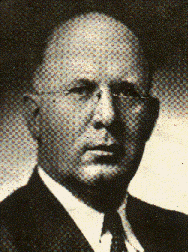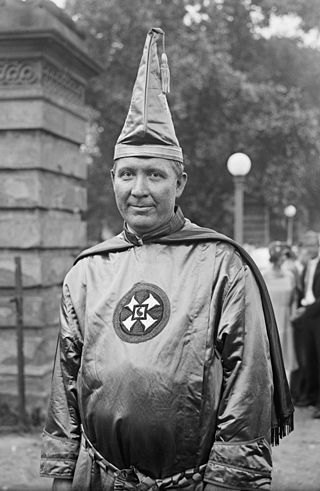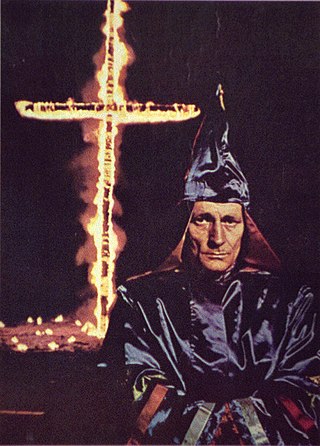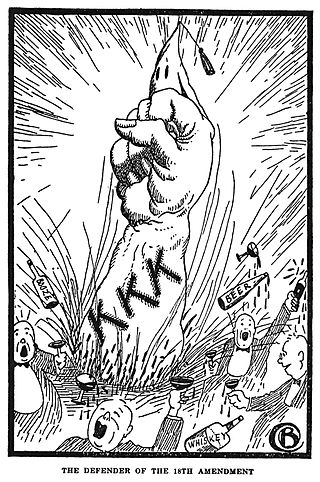Related Research Articles

The Ku Klux Klan, commonly shortened to the KKK or the Klan, is an American white supremacist, right-wing terrorist, and hate group whose primary targets are African Americans, Jews, Latinos, Asian Americans, Native Americans, and Catholics, as well as immigrants, leftists, homosexuals, Muslims, atheists, and abortion providers.
Eldon Lee Edwards was an American Ku Klux Klan leader.
A Kleagle is an officer of the Ku Klux Klan whose main role is to recruit new members and must maintain the three guiding principles: recruit, maintain control, and safeguard.
The Grand Wizard referred to the national leader of several different Ku Klux Klan organizations in the United States and abroad.

James Arnold Colescott was an American white supremacist who was Imperial Wizard of the Knights of the Ku Klux Klan. Under financial pressure from the Internal Revenue Service (IRS) for back taxes, he disbanded the second wave of the original Ku Klux Klan in 1944.

Hiram Wesley Evans was the Imperial Wizard of the Ku Klux Klan, an American white supremacist group, from 1922 to 1939. A native of Alabama, Evans attended Vanderbilt University and became a dentist. He operated a small, moderately successful practice in Texas until 1920, when he joined the Klan's Dallas chapter. He quickly rose through the ranks and was part of a group that ousted William Joseph Simmons from the position of Imperial Wizard, the national leader, in November 1922. Evans succeeded him and sought to transform the group into a political power.
The national leader of the Ku Klux Klan is called either a Grand Wizard or an Imperial Wizard, depending on which KKK organization is being described.

The White Knights of the Ku Klux Klan is a Ku Klux Klan organization which is active in the United States. It originated in Mississippi and Louisiana in the early 1960s under the leadership of Samuel Bowers, its first Imperial Wizard. The White Knights of Mississippi were formed in 1964 when they separated from the Original Knights after the resignation of Imperial Wizard Roy Davis. Roughly 200 members of the Original Knights of Louisiana also joined the White Knights. The White Knights were not interested in holding public demonstrations nor were they interested in letting any information about themselves get out to the masses. Similar to the United Klans of America (UKA), the White Knights of Mississippi were very secretive about their group. Within a year, their membership was up to around six thousand, and they had Klaverns in over half of the counties in Mississippi. By 1967, the number of active members had shrunk to around four hundred.
The United Klans of America Inc. (UKA), based in Alabama, is a Ku Klux Klan organization active in the United States. Led by Robert Shelton, the UKA peaked in membership in the late 1960s and 1970s, and it was the most violent Klan organization of its time. Its headquarters was the Anglo-Saxon Club outside Tuscaloosa, Alabama.

Robert Marvin Shelton was a former car-tire salesman and printer who became nationally famous as the Imperial Wizard of United Klans of America (UKA), a Ku Klux Klan group.

Samuel Green was a Grand Wizard of the Knights of the Ku Klux Klan in the late 1940s, organizing its third and final reformation in 1946.

The Ku Klux Klan has had a history in the U.S. state of New Jersey since the early part of the 1920s. The Klan was active in the areas of Trenton and Camden and it also had a presence in several of the state's northern counties in the 1920s. It had the most members in Monmouth County, and operated a resort in Wall Township.

Edward Young Clarke was the Imperial Wizard pro tempore of the Ku Klux Klan from 1915 to 1922. Prior to his Klan activities, Clarke headed the Atlanta-based Southern Publicity Association. He later served as the president of Monarch Publishing, a book publishing company.
The New York World's exposé of the Ku Klux Klan brought national media to the operations and actions of the Ku Klux Klan beginning on September 6, 1921. The newspaper published a series of twenty one consecutive daily articles, edited by Herbert Bayard Swope, that discussed numerous aspects of Ku Klux Klan including rituals, recruitment methods, propaganda, and hypocrisies in logic. At least eighteen other newspapers nationwide picked up the coverage, which led to national discourse on the activities of the group. These publications included the St. Louis Post-Dispatch, Boston Globe, Pittsburgh Sun, The Plain Dealer (Cleveland), New Orleans Times-Picayune, Galveston News, Houston Chronicle, Seattle Times, Milwaukee Journal, Minneapolis Journal, Oklahoma City Oklahoman, Toledo Blade, Fort Wayne News-Sentinel, Syracuse Herald, Columbus Enquirer-Sun and the Albany Knickerbocker Press. The New York Times ran ads for the article series to increase exposure, while other large papers like the Baltimore Sun quickly picked up the article series instead of advertising for The World. The Ku Klux Klan announced shortly afterward that it would take legal action against all the publications that ran the article series for libel, seeking total damages of over $10 million. Following the exposé, Klan membership significantly increased.
Kleagles are the individuals responsible for recruiting potential Ku Klux Klan (KKK) members. Kleagles, as defined by the Ku Klux Klan: An Encyclopedia, are organizers or recruiters, "appointed by an imperial wizard or his imperial representative to 'sex ' the KKK among non-members". These members were paid 200 dollars per hour by the commission and received a portion of each new member's invitation fee. Recruitment of new KKK members entailed framing economic, political, and social structural changes in favour of and in line with KKK goals. These goals promoted "100 per cent Americanism" and benefits for white native-born Protestants. Informal ways Klansmen recruited members included "with eligible co-workers and personal friends and try to enlist them". Protestant teachers were also targeted for Klan membership.

Ku Klux Klan (KKK) nomenclature has evolved over the order's nearly 160 years of existence. The titles and designations were first laid out in the original Klan's prescripts of 1867 and 1868, then revamped with William J. Simmons's Kloran of 1916. Subsequent Klans have made various modifications.
The National Knights of the Ku Klux Klan is a Klan faction that has been in existence since November 1963. In the sixties, the National Knights were the main competitors against Robert Shelton's United Klans of America.
The Association of Georgia Klans, also known as the Associated Klans of Georgia was a Klan faction organized by Dr. Samuel Green in 1944, and led by him until his death in 1949. At its height the organization had klaverns in each of Georgia's 159 counties, as well as klaverns in Alabama, Tennessee, South Carolina and Florida. It also had connections with klaverns and kleagles in Ohio and Indiana. After Green's death, however, the organization foundered as it split into different factions, was hit with a tax lien and was beset by adverse publicity. It was moribund by the time of the Supreme Court's "Black Monday" ruling in 1954. A second Association of Georgia Klans was formed when Charles Maddox led dissatisfied members out of the U.S. Klans in 1960. This group appears to have folded into James Venable's National Knights of the Ku Klux Klan by 1965. There is also a current Klan group by that name.

Roy Elonzo Davis was a leader and founding member of the 1915 Ku Klux Klan. Davis was Second Degree of the KKK under William J. Simmons and later became National Imperial Wizard (leader) of the Original Knights of the Ku Klux Klan. He worked closely with Simmons, and was a coauthor of the 1921 KKK constitution, bylaws and rituals. Davis spent decades as a KKK recruiter, at one point being named "Royal Ambassador" and an "Official Spokesperson" of the KKK by Simmons. Davis and Simmons were both expelled from the KKK in 1923 by Hiram Wesley Evans, who had ousted Simmons as leader. Simmons started the Knights of the Flaming Sword branch of the KKK and with Davis's help retained the loyalty of many KKK members. Davis was later reappointed second in command of the national KKK organization by Imperial Wizard Eldon Edwards, a position he held until being elected national leader by 1959.
References
- ↑ Michael and Judy Ann Newton eds. The Ku Klux Klan; an encyclopedia Garland Reference Library of the Social Science Vol.499 London and New York; Garland Publishing inc. 1991 pp .xi, 571-2
- ↑ Newton p. 571
- ↑ Newton pp. 181, 571 Newton p.xi say it was active in 9 states, while the entries for US Klans on p. 571 and Eldon Edwards on p. 181 say 10
- ↑ Onion, Rebecca (8 July 2020). "How Georgia's Stone Mountain Became a Monument to White Supremacy". Slate.
- ↑ The Ku Klux Klan: Legacy of Hate Emergence of the UKA Archived 2007-11-10 at the Wayback Machine
- ↑ Newton pp.123, 433
- ↑ James Michael Davis, "MILLER, HORACE SHERMAN," Handbook of Texas Online (http://www.tshaonline.org/handbook/online/articles/fmi93), accessed June 29, 2012. Published by the Texas State Historical Association.
- ↑ Newton pp. 77, 164
- ↑ Newton pp. 9, 273, 513
- ↑ Newton pp.181, 571
- ↑ Newton pp.152-3
- ↑ Newton pp. 29, 291, 573
- ↑ Newton pp. 213-4, 273; United States v.U.S. Klans
- ↑ Newton pp. 223-4, 303, 572
- ↑ Activities of Ku Klux Klan organizations in the United States. Hearings before the Committee on Un-American Activities, House of Representatives, Eighty-ninth Congress, first session pp. 1543-4, 1568 and 1580
- 1 2 Newton pp.285